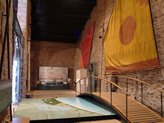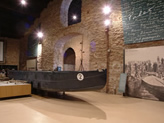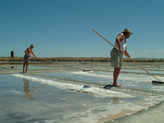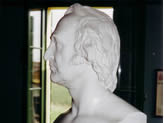Musa. Museo del Sale - Cervia
Magazzini del Sale, Via Nazario Sauro 24 48015 Cervia
Tel. 0544 977592 Fax 0544 977592
email musa@comunecervia.it
web http://musa.comunecervia.it/
![]() Museo di Qualita' 2010-2012
Museo di Qualita' 2010-2012
Apertura: periodo invernale sabato, domenica e festivi ore 15-19; periodo estivo tutti i giorni ore 20.30-23.30; apertura anche su richiesta (chiamando il n. 338 9507741);
Parcheggio: il più vicino è in piazza Andrea Costa
Ingresso gratuito
Accessibile ai diversamente abili
Organizzato a partire dal 1989 all'interno del Magazzino del Sale-Torre, di proprietà comunale, è stato completamente ristrutturato, risistemato ed inaugurato il 24 aprile 2004.Per mezzo di strumenti, immagini e proiezioni il Museo testimonia le fasi della raccolta del sale, prima dell'avvento della meccanizzazione del processo estrattivo, datato verso la fine degli anni '50 del secolo scorso.
Il percorso espositivo inizia dal bookshop da cui si può immediatamente cogliere la "mission" di MUSA ed inquadrare gli elementi dell'esposizione; a disposizione testi, immagini, gadget e il protagonista assoluto: il sale di Cervia. Lo sviluppo del percorso comprende il rapporto dell'uomo con l'acqua rappresentato dal video su grande schermo; a ciò è associata una vetrina contenente alcuni oggetti che rappresentano l'identità storico culturale dell'area.
Un pannello ricorda i toponimi del territorio. Un suggestivo ponte attraversa poi un ampio plastico geografico - territoriale della costa e dell'entroterra per porre l'attenzione sul territorio nel suo rapporto tra saline, città e mare. Pannelli e postazioni multimediali permettono un incontro magico con gli aspetti e le caratteristiche naturalistico - ambientali della Salina di Cervia: l'avifauna, gli altri animali, la botanica.
Alla fine dello spazio museale la natura incontra la memoria, con un grande video che spiega come la storia della salina sia connaturata direttamente con la storia della città di Cervia. Interessante è la rappresentazione attraverso pannelli dell'avventura del sale dall'alba dei tempi fino ai nostri giorni facendoci scoprire l'importanza di un elemento che, non a caso, veniva chiamato oro bianco. Nella grande sala finale in immagine e testi gli elementi della vita reale dei salinari : una grande burchiella originale, attrezzi da lavoro, strumenti per la raccolta del sale. Ovunque appaiono documenti storici emblematici, toponimi tradizionali, nomi dei salinari del passato, volti e immagini della memoria.
Il 10 maggio 2013 è stata inaugurata una nuova ala museale intitolata "La città: storia e memoria"
La Salina Camillone
Ultima delle 144 saline di produzione attive fino al 1959 quando il sistema di produzione divenne industriale e ipiccoli bacini vennero accorpati in grandi vasche di evaporazione e di raccolta. Oggi la salina Camillone resta quale ultima originale salina artigianale, parte integrante del museo del sale ed è lavorata a scopo dimostrativo per far conoscere il duro lavoro dei salinari. Il fondo può produrre dai 500 ai 2000 quintali di sale a stagione. Durante tutto il periodo estivo da giugno a settembre il giovedì e la domenica alle ore 17.00, visite guidate gratuite realizzate dal Gruppo culturale Civiltà Salinara mostrano le varie fasi della attività per la raccolta del sale. La produzione nella salina Camillone, avviene infatti ancora come un tempo artigianalmente, con gli attrezzi in legno e le antiche procedure. I salinari durante le visite spiegano ai partecipanti il lavoro e offrono indicazioni sulle particolari caratteristiche del sale cervese, un sale detto "dolce" in quanto privo dei sali amari che per la particolarità del clima e il metodo di raccolta non riescono a depositare.
Il sale della salina Camillone dal 2004 è diventato presidio Slow Food.
MUSA è stato riconosciuto Museo di Qualità della Regione Emilia Romagna nell'anno 2010.
° ° ° ° ° ° ° ° ° ° ° ° ° ° ° ° ° ° ° ° ° ° ° ° ° ° ° ° ° ° ° ° ° ° ° ° ° ° ° ° ° ° ° ° ° ° ° ° ° ° ° ° ° ° ° °
MUSA was established through the drive and the determination of the Salt Worker's Cultural Association Civiltà Salinara, which has sought to keep the memory of the Cervia salt culture alive by bringing together documents, tools and photographs that bear witness to the world of salt and its production.
MUSA is above all a museum that focuses on man, with culture and tradition at its core.
It opened in 2004 following renovations and finds its permanent home inside the salt storehouse, a magnificent example of late seventeenth century industrial architecture. The depot, which once stored up to 13.000 tons of salt, has an interior structure similar to that of a cathedral. The Museum not only stands as a testament to the history of salt culture, but also aims to be a place of stimulus and reflection as well as a centre offering useful services to the town, its visitors and the general public. A meeting place, a hub of cultural development and research, it conserves, gives value and promotes the study and awareness of the town's cultural heritage, in order to preserve its memory and spark interest in the past and local history.
The outdoor section of the Museum is the Camillone saltpan, the last multiple-harvest, manually-worked saltpan and the last of 150 small saltpans that existed before 1959, the year the structure of the salt works changed, making the transition from manual to industrial harvesting methods.
The Camillone saltpan is still harvested today using tools which are also on display in the Museum, all strictly made in wood and salt-resistant. The hard work of the salt workers produces a particularly high quality raw salt, which can boast its status as a Slow Food presidium since 2004.
Throughout the entire summer season, from June to September, guided tours (offered free of charge by the Civiltà Salinara Cultural Association) which keeps the salt works in operation and runs the Museum, explain the different stages of salt harvesting. The salt workers show visitors how production is carried out, providing information on the special properties of Cervia salt, defined as "sweet" since it is free from those bitter salts that here do not get a chance to deposit on the sodium chloride due to the climate and the daily harvest. During the summer period, visitors can also experience the exciting of extracting salt from the Camillone saltpan under the expert guidance of the salt workers as part of the "Salt Worker for a Day" project.
The Museum tour begins with a full introduction to the relationship between the town and its waters. In fact here you can view a thrilling double video presentation of the salt trail, which traces the journey of a molecule of salt from the seawater to the dining table.
Besides, a model shows the type of territory and the relationship between the saltpans, the town and the sea.
Another video tells the history of the city and its reconstruction.
The Museum also owns a lab area which presents the saltpans and salt production using both traditional methods as well as the industrial system. The ancient, multiple-harvest method is still used to extract salt in the old Camillone saltpan.
Panels provide information on the importance of salt and its trade and the physical-chemical process involved in salt production is also explained.
Another important section concerns the salt workers and it shows some equipment, utensil and structures relating to work in the saltpans. For example in the middle of the room is a burchiella, the flat-bottomed boat used to transport the salt from the tombs to the storehouse. In the Cervia saltpan there were approximately one hundred and the one you can see at the Museum, is the last remaining navigable vessel of its kind.
Every year, for Sapore di Sale, this boat leaves the Museum and laden with white salt, travels along the canal linking the saltpan to the storehouse.
In the area behind the burchiella are miniatures of the tools and means of transport used to work in saltpans, while a mannequin dressed as a salt worker pushing a wheelbarrow dominates the scene.




